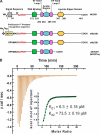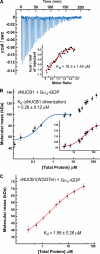Nucleobindin 1 is a calcium-regulated guanine nucleotide dissociation inhibitor of G{alpha}i1
- PMID: 20679342
- PMCID: PMC2951237
- DOI: 10.1074/jbc.M110.148429
Nucleobindin 1 is a calcium-regulated guanine nucleotide dissociation inhibitor of G{alpha}i1
Abstract
Nucleobindin 1 (NUCB1) is a widely expressed multidomain calcium-binding protein whose precise physiological and biochemical functions are not well understood. We engineered and heterologously expressed a soluble form of NUCB1 (sNUCB1) and characterized its biophysical and biochemical properties. We show that sNUCB1 exists as a dimer in solution and that each monomer binds two divalent calcium cations. Calcium binding causes conformational changes in sNUCB1 as judged by circular dichroism and fluorescence spectroscopy experiments. Earlier reports suggested that NUCB1 might interact with heterotrimeric G protein α subunits. We show that dimeric calcium-free sNUCB1 binds to expressed Gα(i1) and that calcium binding inhibits the interaction. The binding of sNUCB1 to Gα(i1) inhibits its basal rate of GDP release and slows its rate and extent of GTPγS uptake. Additionally, our tissue culture experiments show that sNUCB1 prevents receptor-mediated Gα(i)-dependent inhibition of adenylyl cyclase. Thus, we conclude that sNUCB1 is a calcium-dependent guanine nucleotide dissociation inhibitor (GDI) for Gα(i1). To our knowledge, sNUCB1 is the first example of a calcium-dependent GDI for heterotrimeric G proteins. We also show that the mechanism of GDI activity of sNUCB1 is unique and does not arise from the consensus GoLoco motif found in RGS proteins. We propose that cytoplasmic NUCB1 might function to regulate heterotrimeric G protein trafficking and G protein-coupled receptor-mediated signal transduction pathways.
Figures






Similar articles
-
G Protein binding sites on Calnuc (nucleobindin 1) and NUCB2 (nucleobindin 2) define a new class of G(alpha)i-regulatory motifs.J Biol Chem. 2011 Aug 12;286(32):28138-49. doi: 10.1074/jbc.M110.204099. Epub 2011 Jun 8. J Biol Chem. 2011. PMID: 21653697 Free PMC article.
-
Activator of G protein signaling 3 is a guanine dissociation inhibitor for Galpha i subunits.Proc Natl Acad Sci U S A. 2000 Dec 19;97(26):14364-9. doi: 10.1073/pnas.97.26.14364. Proc Natl Acad Sci U S A. 2000. PMID: 11121039 Free PMC article.
-
Ric-8A catalyzes guanine nucleotide exchange on G alphai1 bound to the GPR/GoLoco exchange inhibitor AGS3.J Biol Chem. 2008 Aug 22;283(34):23150-60. doi: 10.1074/jbc.M802422200. Epub 2008 Jun 9. J Biol Chem. 2008. PMID: 18541531 Free PMC article.
-
The GAPs, GEFs, and GDIs of heterotrimeric G-protein alpha subunits.Int J Biol Sci. 2005;1(2):51-66. doi: 10.7150/ijbs.1.51. Epub 2005 Apr 1. Int J Biol Sci. 2005. PMID: 15951850 Free PMC article. Review.
-
Nucleobindins: bioactive precursor proteins encoding putative endocrine factors?Gen Comp Endocrinol. 2012 May 1;176(3):341-6. doi: 10.1016/j.ygcen.2011.11.021. Epub 2011 Dec 3. Gen Comp Endocrinol. 2012. PMID: 22154814 Review.
Cited by
-
Nucleobindin 1 caps human islet amyloid polypeptide protofibrils to prevent amyloid fibril formation.J Mol Biol. 2012 Aug 10;421(2-3):378-89. doi: 10.1016/j.jmb.2012.04.017. Epub 2012 Apr 24. J Mol Biol. 2012. PMID: 22542527 Free PMC article.
-
Does one plus one always equal two? Structural differences between nesfatin-1, -2, and nesfatin-1/2.Cell Commun Signal. 2022 Oct 24;20(1):163. doi: 10.1186/s12964-022-00980-7. Cell Commun Signal. 2022. PMID: 36280843 Free PMC article.
-
Serine protease activity of calnuc: regulation by Zn2+ and G proteins.J Biol Chem. 2013 Jan 18;288(3):1762-73. doi: 10.1074/jbc.M112.382846. Epub 2012 Nov 29. J Biol Chem. 2013. PMID: 23195954 Free PMC article.
-
The RNA-Binding and RNA-Melting Activities of the Multifunctional Protein Nucleobindin 1.Int J Mol Sci. 2023 Mar 24;24(7):6193. doi: 10.3390/ijms24076193. Int J Mol Sci. 2023. PMID: 37047165 Free PMC article.
-
Light-scattering-based analysis of biomolecular interactions.Biophys Rev. 2013 Jun;5(2):147-158. doi: 10.1007/s12551-013-0107-1. Epub 2013 Mar 6. Biophys Rev. 2013. PMID: 23646069 Free PMC article.
References
-
- Oldham W. M., Hamm H. E. (2008) Nat. Rev. Mol. Cell Biol. 9, 60–71 - PubMed
-
- Sakmar T. P., Menon S. T., Marin E. P., Awad E. S. (2002) Annu. Rev. Biophys. Biomol. Struct. 31, 443–484 - PubMed
-
- Gilman A. G. (1987) Annu. Rev. Biochem. 56, 615–649 - PubMed
-
- Pierce K. L., Premont R. T., Lefkowitz R. J. (2002) Nat. Rev. Mol. Cell Biol. 3, 639–650 - PubMed
Publication types
MeSH terms
Substances
Grants and funding
LinkOut - more resources
Full Text Sources
Other Literature Sources
Molecular Biology Databases
Miscellaneous

